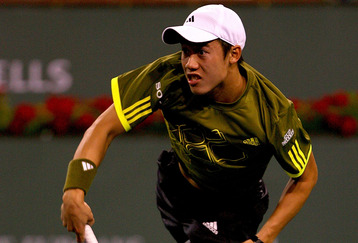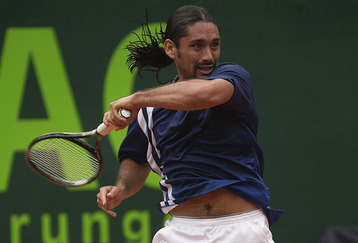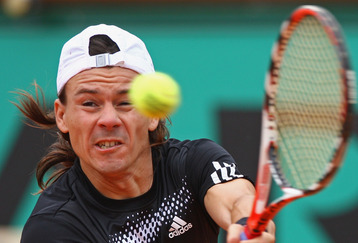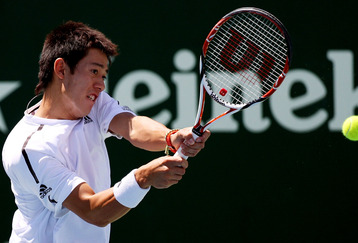Kei Nishikori: The Little Big Man
It’s not news that men’s tennis these days is hardly hospitable to those under six feet in height. While the women’s tour has a player, Justine Henin, who shows that tenacity when combined with one-in-a-billion racket acceleration can make a female of average height a Grand Slam champion, the men’s tour offers no parallels.
In another era, a guy like Kei Nishikori might have had a lot of success ahead of him. The 20-year-old Japan native and current resident of Florida’s skills have been evident ever since he won the Delay Beach title in 2008, outfoxing the huge-hitting James Blake through his speed and his taste for angles and drop shots.
He revealed an arsenal including many of the tools found in the game’s undersized greats of the past, like Rod Laver and Ken Rosewall, namely their court sense, placement, and court coverage.
In the last 20 years though, the men’s game has had only one champion shorter than 5’11”, and that was Gaston Gaudio, who won the 2004 Roland Garros in one of the more improbable conclusions a major has seen. The players most similar to Nishikori in style, Chilean Marcelo Rios and Argentina’s Guillermo Coria, both had opportunities to win slams but couldn’t quite break through.
In Rios’ case, in 1998 the Chilean reached No. 1 in the world by reaching the Australian Open final and then winning the Masters Shields of Indian Wells and Key Biscayne in succession. He would never get a better shot at Slam glory than at that AO final, though, when the streaky (and suspiciously so) sho
tmaker Petr Korda blew the nervous Chilean off the court. Even as he was assuming the No. 1 ranking, though, doubles great Mark Woodforde stated that a 5’9” player would need a lot of heart to win a major; more heart than Rios had ever displayed.
As for Coria, the reason Gaudio’s victory in the 2004 RG was so bizarre was because his fellow 5’9” Argentine Coria was heavily favored in that final, had won the first set 6-0, then won the second … then began struggling physically and failed to put Gaudio away.
At their peaks, Coria and Rios possessed court coverage that few could rival, the ability to hit early and accurately, plus a knack for executing shots that few others could contemplate. Due to height, though, neither man had the luxury of a big serve, and injuries essentially knocked them out of contention for majors in their mid-20s.
Nishikori is listed as one inch taller than Coria or Rios, and the extreme Western grip on his forehand may actually give him more penetration on that wing than either of them had. Coria and Rios, though, were off to better starts at age 20 than Nishikori has been, and that’s due to a couple of factors.
For one, the injury bug than essentially ruined their careers has struck early in this case, as the Japanese prodigy missed most of 2009 – it’s last three Grand Slams, in fact – with an elbow ailment. The other problem for Nishikori is that, unlike Rios or Coria, he does not have surface specialization to maintain his results.
When a tennis pro is referred to as a clay (or, rare as it has become, grass) court specialist, it’s generally not a compliment, because it suggests that they are only a threat in one venue. That isn’t what is meant here – Rios in particular won seven hard court titles and two on carpet in his career – but the two
South American players had a natural affinity for the dirt that many of their peers did not, and had clay to sustain their rankings and confidence if their efforts at crossing over onto asphalt fell short. A young Japanese player would not have that luxury, as evidenced by the fact that his country’s premier event – the Japan Open Tennis Championships – takes place on outdoor hard courts.
In essence, Nishikori is just another hard court specialist in a game full of them, only he’ll need to work harder and rely more on good luck than, say, Juan Martin del Potro to put up great results. Therefore, he may not even come as close as Rios and Coria did.
So far, the work he has put in has netted just that one title in Delray Beach — where he beat Sam Querrey and Blake back-to-back. It’s also allotted him three career Grand Slam match wins, all of which came at the 2008 US Open, but one of which included then world No. 4 David Ferrer. Since then, it’s been mostly injury and recovery for the talented youth, but recent results have been promising.
Now ranked No. 244 in the world – just slightly higher than when he won his first title – Nishikori has just won two clay events in a row at the Challenger level, and is now set to play his first ever Roland Garros.
In round one, he’ll face Santiago Giraldo of Colombia, who may not be a clay court expert on par with Rios or Coria, but will certainly have more experience than the Japanese youth based just on his country of origin.
Nishikori’s flair and natural feel, though, are rare qualities, and give him at least respectable odds of reaching round two.
May we see a lot more of this young man in events to come.




I am pretty much interested in sports and this alluring news about that matches were very pleasing for me. I really like to read your blog because these things are really amazing to read when you missed it.